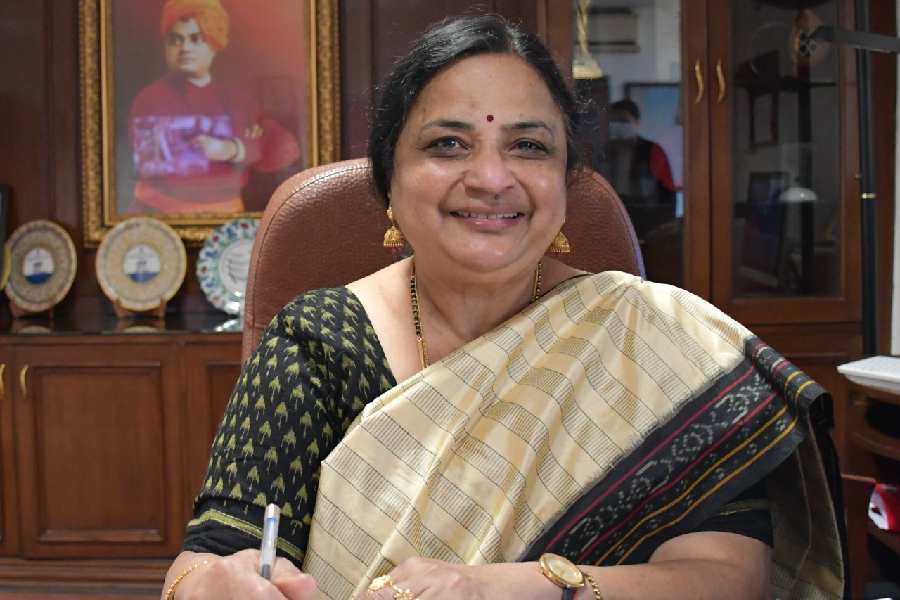As one enters the cavernous gallery space of Emami Art on the ground floor of the Kolkata Centre for Creativity on the EM Bypass at Anandapur, one hears in one’s head the soft, inaudible strains of music that seem to emanate from the suite of Braille characters punched on white sheets.
As one turns a bend, one confronts a procession of beautiful black-framed transparent rectangles in solid colours with circular mirrors embedded in them. These varicolored rectangles stick out of the left wall like street signage. In the left hand corner hangs a large rectangular looking glass with the word “Religion” inscribed on it in neon light.
The mirror seems to have hidden depths — reflections are multiplied beneath its surface.
A large chamber has been created in the right hand corner of the gallery space inside which the lights are dim. The imaginary music of Braille gives way to the cacophony and crude brilliance of gold. Even from afar, the glitter of the nine gold frames is visible in the gloom. Inside each frame is inscribed the words — God, Religion, Casteism, Racism, Narcissism, Nationalism, Technology, Regionalism, Capitalism.
Each teakwood frame, both inside and outside the chamber, is elaborately carved. The exhibition trails off with the quiet notes of a nocturne, as it were — dark grey sheets of paper flecked with gold displayed outside the chamber.
This is Bose Krishnamachari’s first solo show, “The Mirror sees Best in the Dark”, in nine years. What with his busy schedule of organising the edgy Kochi-Muziris Biennale, albeit with other colleagues, and his various activities on the international art scene, he took two years to put together this massive show. Bose (named after Subhas Chandra) sports a goatee and eye-catching glasses, of which he must have a collection. Born around 1963, this is his 30th year of making art, he declares proudly.
Bose speaks in soft tones that belie the politically alive ideas that galvanise his art, as his current exhibition is evidence of. Coming at a time when the country is being torn asunder by two pieces of legislation aimed at driving a wedge between communities, this exhibition makes a powerful statement against majoritarianism and the brute force it represents.
When we met on Monday afternoon, Bose defined his ongoing show succinctly: “Outside it is minimalism. Inside it is chaos created by maximalism.”
Bose, who is from Mangattukara, a village close to Kochi, in the course of his interview went back to his days at Goldsmiths College in London where he did his Masters in 1999-2000. His tutor was Michael Craig-Martin, the contemporary conceptual artist and “influential pedagogue” noted for fostering the Young British Artists. While approving of the way his work was shaping up, Craig-Martin advised Bose to take colour and form to the extreme language of art making.
Bose says when one looks at the history of extremity, Jackson Pollock had already done this. When Bose began to paint with acrylic the bands of pulsating colours that seemed to be tied up in knots, he had to finish each painting in haste before the pigments dried up, and had to avoid layering to retain their “freshness.”
A psychedelic effect was created as a result. Allowing for the role that chance and accident played in his work, Bose had to “improvise” on canvas stretched out on a table, his body defining 360 degrees in the process.
From his student days at the Sir JJ School of Art in Mumbai, which he joined in 1986, Bose has tasted success. While still a student, in 1991 he held a show that was a sell-out.
“It gave me so much confidence,” he says in retrospect.
Early in life, he had joined the theatre. He did a little music and even Bharatanatyam but gave up as he was afraid of public performance. After a spell of illness at 17, when he was in and out of coma, he made up his mind to be an artist. It was painless, he announces nonchalantly.
His current exhibition is a “juxtaposition of maximalism and minimalism”.
For minimalism, Braille is the “best language as the artist has to feel the language. Maths is involved in Braille. It is like a musical score — abstract. I could improvise with the graphite sheets which are handmade with the help of machines”, says Bose, referring to the series of dark grey engraved rectangles that are part of this large and varying body of work.
Instead of embossing the Braille characters as they should be, the characters were perforated. “The philosophy of extremities is co-existing in life. Look at what’s happening in the nation and outside world. The 10 letters used in these works (the word “Chauvinism” is the 10th in Braille characters) show that people are obsessed with certain kinds of things. What Marx called ‘opium’. These are problems originating from self. Obsession is dangerous. You can love or like things, but you have to keep your distance from what you love. I want to sensitise myself and the public,” Bose contends.
Hence, inside the “sanctum sanctorum”, as he calls it, “embellishment and ornamentation” are overblown, connoting “showing off and wealth.”
Bose’s father owned a furniture shop and skilled art such as portraiture and landscape came naturally to him. Even when the abundance of gold looks kitschy, one cannot but marvel at the level of skill involved in crafting the intricately carved frames that remind one of the richness of Tanjore paintings.
He also designed the dark figured wallpaper of the darkened chamber. “These works have lots of layers and materiality. Everything from teak, granite, graphite, acrylic mirrors, steel, copper, ceramics were used so when you look at it you get engrossed. The mirror is a receiver — it receives anything in front of you.”
This is an embodiment of dissonance confronting harmony, and it can puzzle viewers.










